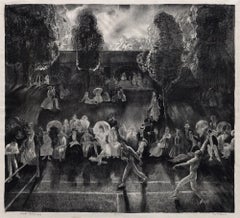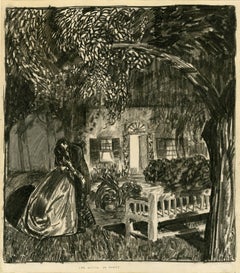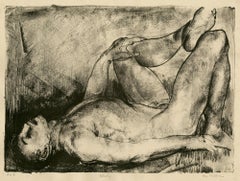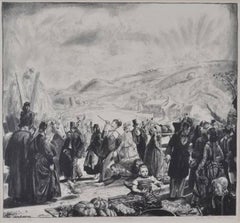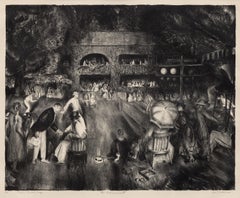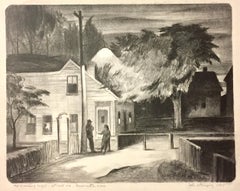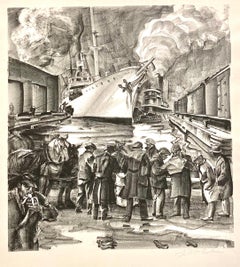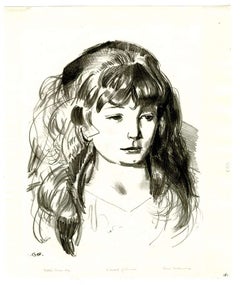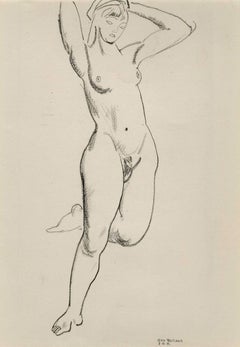George Wesley Bellows Art
American, 1882-1925
George Bellows, an American artist, was born in Columbus, Ohio in 1882, the only child of a successful building contractor from Sag Harbor, New York. He entered Ohio State University in 1901, where he played baseball and basketball and made drawings for college publications. He dropped out of college in 1904, went to New York, and studied under Robert Henri (American, 1865 – 1929) at the New York School of Art, where Edward Hopper (American, 1882 – 1967), Rockwell Kent (American, 1882 – 1971), and Guy Pène du Bois (American, 1884 – 1958) were his classmates. A superb technician who worked in a confident, painterly style, Bellows soon established himself as the most important realist of his generation. He created memorable images of club fights, street urchins swimming in the East River, and the Pennsylvania Station excavation site and garnered praise from both progressive and conservative critics.
In 1910 Bellows began teaching at the Art Students League and married Emma Story, by whom he had two daughters. After 1910 Bellows gradually abandoned the stark urban realism and dark palette characteristic of his early work and gravitated toward painting landscapes, seascapes, and portraits.
Bellows helped organize the Armory Show in 1913, in which five of his paintings and a number of drawings were included. That year he was elected a full member of the National Academy of Design. He had leftist political views and contributed illustrations to the Socialist publication The Masses from 1912 to 1917. Bellows began to make lithographs in 1916 and his exceptional talent engendered a revival of interest in the medium. He worked in Maine, in Carmel, California, and in Middletown, Rhode Island, and was a founding member of the Society of Independent Artists and a charter member of the Association of American Painters and Sculptors. In 1919 he taught at the Art Institute of Chicago.
Bellows, who never went to Europe, is regarded as a quintessential American artist whose vigorous style enabled him to explore a wide range of subjects from scenes of modern urban life to portraits of his daughters, to turbulent Maine seascapes. As an early biographer noted, Bellows “caught the brute force of the prizefighter, the ruggedness of the country pasture, the essence of childhood and recorded them appropriately not only for his own generation but for all time.”[1]
[1] [Frederick A. Sweet], George Bellows: Paintings, Drawings and Prints (Art Institute of Chicago, IL, 1946).
Robert Torchia September 29, 2016to
9
9
9
6
2
Tennis (Tennis Tournament)
By George Wesley Bellows
Located in Palm Desert, CA
A lithograph by George Bellows. “Tennis (Tennis Tournament)” is a realistic lithograph on paper in black and white by American Realist, George Bellows. Bellows’ depictions of sportin...
Category
1920s American Realist George Wesley Bellows Art
Materials
Lithograph
The Mouth of Honey
By George Wesley Bellows
Located in Fairlawn, OH
The Mouth of Honey
Lithographic crayon and mixed media on paper mounted to support paper
Initialed by the artist "GB" bottom center on image. (see photo)
Titled in pencil in bottom m...
Category
1920s Ashcan School George Wesley Bellows Art
Materials
Crayon
Man on His Back, Nude
By George Wesley Bellows
Located in Fairlawn, OH
Man on His Back, Nude
Lithograph, c. 1916
Signed by the artist lower right: Geo Bellows (see photo)
Annotated bottom left: No. 3 by the artist (see photo)
An unredorded trial proof b...
Category
1910s Ashcan School George Wesley Bellows Art
Materials
Lithograph
The Irish Fair
By George Wesley Bellows
Located in Fairlawn, OH
Irish Fair
Lithograph, 1923
Signed and numbered in pencil by the artist (see photo)
Titled "Irish Fair" by the artist in pencil
Edition: 84
Housed in an archival frame with acid free matting (see photo)
Provenance:
Estate of the artist, Bellows Family Trust
H.V. Allison & Company (label)
Private Collection, Columbus
References And Exhibitions:
Reference: Mason 153
Note: An illustration commissioned by The Century Company for Don Byrne's novel The Wind Bloweth
Image: 18 7/8 x 21 3/8"
Frame: 29 1/2 x 30 1/2"
“Eleven on a hot July morning, and the little town...
Category
1920s Ashcan School George Wesley Bellows Art
Materials
Lithograph
PUNCHINELLO IN THE HOUSE OF DEATH.
By George Wesley Bellows
Located in Portland, ME
Bellows, George (American 1882-1925). PUNCHINELLO IN THE HOUSE OF DEATH.Mason 151 Lithograph, 1923. Edition of 60. Titled and signed in pencil by Bellows, and also signed "Bolton Bro...
Category
1920s George Wesley Bellows Art
Materials
Lithograph
The Tournament (Tennis at Newport)
By George Wesley Bellows
Located in Palm Desert, CA
A lithograph by George Bellows. “The Tournament (Tennis at Newport)” is a realistic lithograph on paper in black and white by American Realist artist, George Bellows. Bellows' depictions of sporting / leisure scenes are unique and valuable. This artwork is edition 56/63 with framed dimensions of 26 x 29 x 1 1/4 inches and has been in the same private collection for almost four decades. The artwork is signed in pencil, lower right, "G. Bellows.”
Provenance:
Catherine E Burns...
Category
1920s American Realist George Wesley Bellows Art
Materials
Lithograph
The Hold Up, First State
By George Wesley Bellows
Located in Fairlawn, OH
Signed in pencil by the artist lower right
Titled "Hold Up" by the artist in pencil.
Signed by the printer Bolton Brown lower left.
Edition: 42 in this state
Note: In The Hold Up, se...
Category
1920s American Realist George Wesley Bellows Art
Materials
Lithograph
THE LIFE CLASS - SECOND STONE (THE MODEL, LIFE CLASS).
By George Wesley Bellows
Located in Portland, ME
Bellows, George. THE LIFE CLASS - SECOND STONE (THE MODEL, LIFE
CLASS). Mason 43, Bellows 193. Lithograph, 1917. Edition of 49,
signed by Bellows. Inscribed "No.20," titled and sign...
Category
Early 20th Century George Wesley Bellows Art
Materials
Lithograph
red ballboy or Studies for "Tennis Tournament"
By George Wesley Bellows
Located in Fairlawn, OH
Red Ballboy or Studies for "Tennis Tournament"
Crayon on paper, c. 1920
Unsigned
Condition: three vertical folds created by the artist to transport the drawing from the tennis match ...
Category
1910s Ashcan School George Wesley Bellows Art
Materials
Graphite
Related Items
John W. Gregory, Approaching Night, Atwood Avenue, Provincetown, MA
By John W. Gregory
Located in New York, NY
Gregory worked mostly in lithography, probably learned at the Art Students League in New York City. However he often drew New England subjects, so this evening Provincetown scene is ...
Category
1930s Ashcan School George Wesley Bellows Art
Materials
Lithograph
Joseph Webster Golinkin, On the Dock, Banana Boat, New Orleans
By Joseph Webster Golinkin
Located in New York, NY
Chicago-born Golinkin studied at the Artist Students League with George Luks. After working as an illustrator for New York papers he joined the Navy in 1939 and retired as a Rear Adm...
Category
1930s Ashcan School George Wesley Bellows Art
Materials
Lithograph
$1,200
H 14.5 in W 13.25 in
A Rash Act: erotic drawing of nude blonde, redhead, and man with art deco motifs
By Ronald Brooks Kitaj
Located in New York, NY
A colorful erotic daydream drawing of a nude blonde fantasizing, with a redhead woman, and man. Green and purple patterns on hair and pillows, and art deco motifs, adorn this sensual...
Category
1970s Realist George Wesley Bellows Art
Materials
Lithograph
Marquet's Mannequin /// Mel Ramos Figurative Nude Woman Lady Pop Art Lithograph
By Mel Ramos
Located in Saint Augustine, FL
Artist: Mel Ramos (American, 1935-2018)
Title: "Marquet's Mannequin"
*Unsigned proof
Year: 1979
Medium: Original Lithograph on unbranded white wove paper
Limited edition: an unsigned...
Category
1970s Pop Art George Wesley Bellows Art
Materials
Lithograph
$900 Sale Price
25% Off
H 28.13 in W 21.07 in
"Beach at Atlantic City, New Jersey" Amy Londoner, Ashcan School, Figurative
By Amy Londoner
Located in New York, NY
Amy Londoner
Beach at Atlantic City, circa 1922
Signed lower right
Pastel on paper
Sight 23 x 18 inches
Amy Londoner (April 12, 1875 – 1951) was an American painter who exhibited at the 1913 Armory Show. One of the first students of the Henri School of Art in 1909. Prior to the Armory Show of 1913, Amy Londoner and her classmates studied with "Ashcan" painter Robert Henri at the Henri School of Art in New York, N.Y. One notable oil painting, 'The Vase', was painted by both Henri and Londoner.
Londoner was born in Lexington, Missouri on April 12, 1875. Her parents were Moses and Rebecca Londoner, who moved to Leadville, Colorado, by 1880. In 1899, Amy took responsibility for her father who had come to Los Angeles from Leadville and had mental issues. By 1900, Amy was living with her parents and sister, Blanche, in the vicinity of Leadville, Denver, Colorado. While little was written about her early life, Denver City directories indicated that nineteenth-century members of the family were merchants, with family ties to New York, N.Y. The family had a male servant. Londoner traveled with her mother to England in 1907 then shortly later, both returned to New York in 1909. Londoner was 34 years old at the time, and, according to standards of the day, should have married and raised a family long before. Instead, she enrolled as one of the first students at the Henri School of Art in 1909.
At the Henri School, Londoner established friendships with Carl Sprinchorn (1887-1971), a young Swedish immigrant, and Edith Reynolds (1883-1964), daughter of wealthy industrialist family from Wilkes-Barre, PA. Londoner's correspondence, which often included references to Blanche, listed the sisters' primary address as the Hotel Endicott at 81st Street and Columbus Avenue, NYC. Other correspondence also reached Londoner in the city via Mrs. Theodore Bernstein at 252 West 74th Street; 102 West 73rd Street; and the Independent School of Art at 1947 Broadway. In 1911, Londoner vacationed at the Hotel Trexler in Atlantic City, NJ. As indicated by an undated photograph, Londoner also spent time with Edith Reynolds and Robert Henri at 'The Pines', the Reynolds family estate in Bear Creek, PA.
Through her connections with the Henri School, Londoner entered progressive social and professional circles. Henri's admonition, phrased in the vocabulary of his historical time period, that one must become a "man" first and an artist second, attracted both male and female students to classes where development of unique personal styles, tailored to convey individual insights and experiences, was prized above the mastery of standardized, technical skill. Far from being dilettantes, women students at the Henri School were daring individuals willing to challenge tradition. As noted by former student Helen Appleton Read, "it was a mark of defiance,to join the radical Henri group."
As Henri offered educational alternatives for women artists, he initiated exhibition opportunities for them as well. Troubled by the exclusion of work by younger artists from annual exhibitions at the National Academy of Design, Henri was instrumental in organizing the no-jury, no-prize Exhibition of Independent Artists in 1910. About half of the 103 artists included in the exhibition were or had been Henri students, while twenty of the twenty-six women exhibiting had studied with Henri. Among the exhibition's 631 pieces, nine were by Amy Londoner, including the notorious 'Lady with a Headache'. Similarly, fourteen of Henri's women students exhibited in the groundbreaking Armory Show of 1913, forming about eight percent of the American exhibitors and one-third of American women exhibitors. Of the nine documented works submitted by Londoner, five were rejected, while four pastels of Atlantic City beach scenes, including 'The Beach Umbrellas' now in the Remington Collection, were displayed.
Following Henri's example, Londoner served as an art instructor for younger students at the Modern School, whose only requirement was to genuinely draw what they pleased. The work of dancer Isadora Duncan, another artist devoted to the ideals of a liberal education, was also lauded by the Modern School. Henri, who long admired Duncan and invited members of her troupe to model for his classes, wrote an appreciation of her for the Modern School journal in 1915. She was also the subject of Londoner's pastel Isadora Duncan and the Children: Praise Ye the Lord with Dance. In 1914, Londoner traveled to France to spend summer abroad, living at 99 rue Notre Dames des Champs, Paris, France. As the tenets of European modernism spread throughout the United States, Londoner showed regularly at venues which a new generation of artists considered increasingly passe, including the annual Society of Independent Artists' exhibitions between 1918 and 1934, and the Salons of America exhibition in 1922. Londoner also exhibited at the Morton Gallery, Opportunity Gallery, Leonard Clayton Gallery and Brownell-Lambertson Galleries in NYC. Her painting of a 'Blond Girl' was one of two works included in the College Art Associations Traveling Exhibition of 1929, which toured colleges across the country to broad acclaim.
Londoner later in life suffered from illnesses then suffered a stroke which resulted in medical bills significantly mounting over the years that her old friends from the Henri School, including Carl Sprinchorn, Florence Dreyfous, Florence Barley, and Josephine Nivison Hopper, scrambled to raise funds and find suitable long-term care facilities for Londoner. Londoner later joined Reynolds in Bear Creek, PA. Always known for her keen wit, Londoner retained her humor and concern for her works even during her illness, noting that "if anything happens to the Endicott, I guess they will just throw them out." Sprinchorn and Reynolds, however, did not allow this to happen. In 1960, Londoner's paintings 'Amsterdam Avenue at 74th Street' and 'The Builders' were loaned by Reynolds to a show commemorating the Fiftieth Anniversary of the Exhibition of Independent Artists in 1910, presented at the Delaware Art Center, Wilmington, DE. In the late 80's, Francis William Remington, 'Bill Remington', of Bear Creek Village PA, along with his neighbor and artist Frances Anstett Brennan, both had profound admiration for Amy Londoner's art work and accomplishments as a woman who played a significant role in the Ashcan movement. Remington acquired a significant number of Londoner's artwork along with Frances Anstett Brenan that later was part of an exhibition of Londoner's artwork in April 15 of 2007, at the Hope Horn...
Category
1920s Ashcan School George Wesley Bellows Art
Materials
Paper, Pastel
$3,750
H 29.5 in W 24.5 in
Some do not (A) R.B. Kitaj erotic nude drawing of nude blonde with man on bed
By Ronald Brooks Kitaj
Located in New York, NY
An erotic dalliance between a nude blonde woman lying down, and nude man, on a bed with white sheets. Subtle shades of peach, tan, yellow, and grey and black shadow behind the couple...
Category
1970s Realist George Wesley Bellows Art
Materials
Lithograph
John W. Gregory, North End Street Scene (Boston)
By John W. Gregory
Located in New York, NY
Boston's North End is a charming Italian neighborhood with small buildings and twisting streets. The artist, John W. Gregory, captures the feeling of a pleasant afternoon visiting th...
Category
1930s Ashcan School George Wesley Bellows Art
Materials
Lithograph
Battle Scene, Spanish American War
By Francis Luis Mora
Located in New York, NY
Francis Luis Mora was considered one of America's finest "sketchers". A collection of his Sketchbooks are at the Smithsonian and this work came out of one in the early 1990's from t...
Category
1890s Ashcan School George Wesley Bellows Art
Materials
Graphite
$1,040 Sale Price
20% Off
H 13 in W 15.5 in D 2 in
Reclining Nude.
By Reza Yahyaei
Located in Berlin, MD
Reza Yahyaei (born 1948, France). Reclining nude female against bold color strokes. Matisse like simplicity of lines. A very striking piece, unframed...
Category
Mid-20th Century Abstract Impressionist George Wesley Bellows Art
Materials
Lithograph
The Lovers
By Peter Max
Located in Berlin, MD
Peter Max (German / American 1937 - Present) The Lovers. Abstract of two nude women on a bed in vibrant colors. The print is on thick woven paper and is...
Category
Late 20th Century Pop Art George Wesley Bellows Art
Materials
Lithograph
Cercle Artistique de Schaerbeek
By Georges Henri Privat-Livemont
Located in West Hollywood, CA
The gallery is opening its private collection of art nouveau and art deco paintings, lithographs and antiques for the first time in more than twenty years.
Presenting an original li...
Category
1890s Art Nouveau George Wesley Bellows Art
Materials
Lithograph
Irving Guyer, Roll Them Bones, Depression-era African-American men at craps
By Irving Guyer
Located in New York, NY
An American Depression-Era subject of African-American men playing craps by Irving Guyer.. (Craps is a game of chance that required neither skill nor strategy. The object is to predi...
Category
1930s Ashcan School George Wesley Bellows Art
Materials
Etching
Previously Available Items
Sketch of Anne
By George Wesley Bellows
Located in Fairlawn, OH
Sketch of Anne
Lithograph, 1923-1924
Signed and titled by the artist, signed by his printer Bolton Brown
Edition: 42
Printed by Bolton Brown (see photo of his signature in pencil)
Pr...
Category
1920s Ashcan School George Wesley Bellows Art
Materials
Lithograph
Standing Female Nude
By George Wesley Bellows
Located in Fairlawn, OH
Standing Female Nude
Graphite on wove paper, c. 1915
Signed by the artist's daughter, Jean Bellows Booth (JBB) (see photo)
Provenance:
Estate of the artist
H. V. Allison Galleries (#94 on partial label), agent for Bellows Trust
Ronald Sloter, Columbus, OH, noted collector
Columbus College of Art and Design
Biography
George Wesley Bellows grew up in Columbus, Ohio, the son of a devout and solidly Midwestern building contractor, and a mother who hoped that her son would become a Methodist Bishop. He always felt deeply ambivalent about his father, noting at the time of his death that, "He was a wonderfully fine man, yet being fifty-five when I appeared, his point of view, his character even, belonged to so remote a past that I look upon many of his ideas to this day with amazement and sorrow."
Teased as a sissy by his classmates, George Bellows quickly learned to defend himself with his fists, and compensated for his gangling awkwardness by becoming an outstanding athlete, particularly in baseball. His love of drawing was kindled early since he was forbidden to play outside on Sundays but allowed to draw while his mother read aloud from the Bible.
At Ohio State University, George Bellows proved a spirited extrovert, excelling in baseball as well as in the new sport of basketball, singing in theatricals, and producing drawings of Gibson-like girls for the university's magazine. Bellows's athletic prowess almost diverted him from a career in art, but in 1904 he decided to turn down a professional baseball contact and move to New York City to study painting.
The sprawling, teaming city of New York was a revelation to him after the neat lawns and tidy homes of Columbus. There he quickly fell under the spell of the charismatic teacher Robert Henri, who introduced him to Shaw, Ibsen and socialism, and inspired him to shift from drawing Gibson Girls to painting the life of the streets. Bellows was still a relative newcomer to New York when Henri and his followers staged their famous exhibition of "The Eight" at the Macbeth Gallery, and consequently he was not included. But in spirit his work belongs with that display - perhaps someday Henri’s group will be rechristened "The Nine" to pay tribute to the fact that George Bellows was the painter whose work best expresses the goals of the group.
In 1906 Bellows painted his first masterpiece, "The Cross-Eyed Boy." He followed with several other equally memorable likenesses of street urchins, and then expanded his vision with a series of masterful urban scenes that record such subjects as boys swimming...
Category
1920s Ashcan School George Wesley Bellows Art
Materials
Graphite
Emma and Marjorie on a Sofa
By George Wesley Bellows
Located in Fairlawn, OH
Emma and Marjorie on a Sofa
Lithograph printed on chine paper, 1921
Signed by the artist lower right (see photo)
Signed by the printer Bolton Brown lower left (see photo)
Edition: 44...
Category
1920s Ashcan School George Wesley Bellows Art
Materials
Lithograph
Hungry Dogs, Second State
By George Wesley Bellows
Located in Fairlawn, OH
Hungry Dogs, Second State
Lithograph, 1916
Considered to be the artist's first lithograph
Signed, titled and numbered in pencil by the artist (see photo)
Titled "Hungry Dogs" by the artist in pencil (see photo)
Edition: at least 41 impressions, this "No. 14"
Reference: Masson 1B ii/II
Condition: Printer's ink in margins, otherwise very good condition.
Note: The artist's first lithograph. The "Ash Can School" is derived from this image and its' depiction of an ash can in the lower left of the composition. A very important American 20th Century print. This image gave rise to the naming of the most important American style of painting in the first quarter of the 20th century.
Provenance: Estate of the artist
H. V. Allison & Co., New York (Bellows estate dealer)
Private Collection, Columbus, Ohio (Bellows city of birth)
From 2001 to 2018, Thomas French Fine Art was the exclusive agent for the Bellows Family Trust. Thomas French Fine Art and The Bellows Trust hold a large inventory of original lithographs and drawings created by George Wesley Bellows that were left in the artist’s studio at the time of his unexpected early death. All of George Bellows’ original lithographs were printed by the artist or under his direct supervision. There are no posthumous impressions of any of George Bellows’ lithographs...
Category
1910s American Realist George Wesley Bellows Art
Materials
Lithograph
George Bellows "Irish Fair" Original Signed Lithograph, circa 1923
By George Wesley Bellows
Located in San Francisco, CA
George Bellows (1882-1925) "Irish Fair" original signed Lithograph circa 1923
Pencil signed and titled by the artist. From a limited edition of 84.
The Irish Fair show well dre...
Category
Early 20th Century American George Wesley Bellows Art
Materials
Other
Framed Oil Painting by George Wesley Bellows
By George Wesley Bellows
Located in Atlanta, GA
An oil painting depicting an unidentified young man by George Wesley Bellows (1882-1925), a member of American Ashcan School in the circle of Robert Henri. This portrait is in its original condition with the period frame. Signed G.Bellows BR on canvas. Marked Robbins on the back of the canvas. This piece has been authenticated (see provenance below).
Provenance:
From the estate of Leona Robbins Collection, FL. A female student of Robert Henri.
Sotheby's American Art sale on 09-28-2012 Lot number 111.
It was authenticated and added to George Bellow...
Category
Early 20th Century American American Classical George Wesley Bellows Art
Materials
Canvas, Giltwood
BETWEEN ROUNDS
By George Wesley Bellows
Located in Portland, ME
Bellows, George (American 1882-1925). BETWEEN ROUNDS NO.1 (LARGE). Mason 25, Bellows 52. Lithograph, 1916.
Edition of 58, this signed by Jean Bellows Beeth, the artist's daughter, a...
Category
1910s George Wesley Bellows Art
Materials
Lithograph
ARTIST'S EVENING (AT PETIPAS)
By George Wesley Bellows
Located in Portland, ME
Bellows, George. ARTIST'S EVENING (AT PETIPAS). M.19. Lithograph, 1916. Edition of 65. A lifetime impression, signed by the artist in pencil and numbered "57." Printed on thin Japane...
Category
Early 20th Century American Modern George Wesley Bellows Art
Materials
Lithograph
Between Rounds, Small, Second Stone
By George Wesley Bellows
Located in Fairlawn, OH
Signed and titled by the artist
Signed lower left by the printer, Bolton Brown
Edition 42
Printed on fine chine paper, mounted to paper board, most probably by the artist’s first print dealer, Frederick Keppel & Company, in the mid 1920’s. This is consistent with other similar mounted examples in the estate of the artist. The Keppel firm was active from 1868 to 1941, when Harry V. Allison started his own gallery, H. V. Allison Gallery...
Category
1920s Ashcan School George Wesley Bellows Art
Materials
Lithograph
The Black Hat (Emma in a Black Hat)
By George Wesley Bellows
Located in New York, NY
George Bellows (1882-1925), The Black Hat (Emma in a Black Hat), lithograph, 1921. Reference: Morse 113. From the edition of 55. Signed in pencil by the arti...
Category
1920s American Realist George Wesley Bellows Art
Materials
Lithograph
Preliminaries (to the Big Bout).
By George Wesley Bellows
Located in Storrs, CT
Mason 24. 15 7/8 x 19 5/8 (sheet 23 x 27 1/4). Edition 67, #2. A rich impression printed on white wove paper paper, with full margins. Provenance: ACA Galleries, private New York collection. This is a fine lifetime impression. Signed, numbered and titled in pencil by the artist.
In this early impression, there are four spotlights in the top of the image. The three in the right were eliminated in subsequent impressions.
-----------------------------------------------------------------------------------------
Bellows...
Category
20th Century Ashcan School George Wesley Bellows Art
Materials
Lithograph
Sixteen East Gay Street
By George Wesley Bellows
Located in Fairlawn, OH
Signed by the artist and his printer Bolton Brown
Edition: 72
Provenance:
H.V. Allison & Co., Inc., New York (label)
References And Exhibitions:
This nostalgic scene o...
Category
1920s George Wesley Bellows Art
Materials
Lithograph
George Wesley Bellows art for sale on 1stDibs.
Find a wide variety of authentic George Wesley Bellows art available for sale on 1stDibs. You can also browse by medium to find art by George Wesley Bellows in lithograph, graphite, pencil and more. Not every interior allows for large George Wesley Bellows art, so small editions measuring 8 inches across are available. Customers who are interested in this artist might also find the work of Fred Nagler, Frank Benson, and John Sloan. George Wesley Bellows art prices can differ depending upon medium, time period and other attributes. On 1stDibs, the price for these items starts at $3,500 and tops out at $55,000, while the average work can sell for $7,800.
Artists Similar to George Wesley Bellows
Questions About George Wesley Bellows Art
- 1stDibs ExpertApril 5, 2022Cliff Dwellers by George Bellows is a painting created in 1913 that’s meant to depict the explosive population growth that New York City was experiencing at the time. Specifically, the painting is of a hot summer’s day in New York City’s Lower East Side. On 1stDibs, find a variety of original artwork from top artists.
- 1stDibs ExpertApril 5, 2022George Bellows created paintings that focussed on realism. His oil paintings mixed urban studies with social and political themes, mainly centered around New York City. On 1stDibs, you can shop a selection of George Bellow’s pieces from some of the world’s top art dealers from the comfort of your home.
